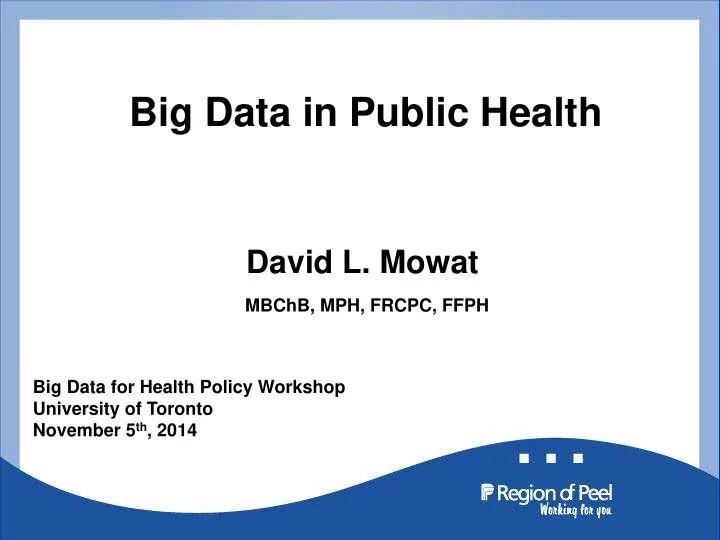

Big Data in Public Health David L. Mowat MBChB, MPH, FRCPC, FFPH Big Data for Health Policy Workshop University of Toronto November 5 th , 2014
Example 1: Low Birth Weight Low Birth Weight, Pre-Term and Small-for-gestational-age Rate, Peel and Ontario, 2002-2006 Combined Peel Ontario Low birth weight rate † 6.9 6.0 Pre-Term birth rate † 7.5 7.5 Small-for-gestational-age 10.8 8.7 rate †
Birth Weight by Maternal Region of Birth, Ontario
Example 2: Remaining Life Expectancy at Age 25, by Low Income Census Tract Quintiles, Peel, 2005 Years remaining 80 Males: Q5-Q1=0.4 yrs 70 Females: 60 Q5-Q1= -2.2 50 yrs 40 30 20 LI1 (Poorest) LI2 LI3 LI4 LI5 (Richest) 56.6 57.3 56.8 57.3 57 Male LE 61.6 60.6 61 59.9 59.4 Female LE Low Income Census Tract Quintiles Male LE Female LE Sources: Ontario Mortality Database 2005, HELPS (Health Planning System), Ministry of Health Promotion; 2006 Census, Statistics Canada
Remaining life expectancy at age 25 by immigrant status and income adequacy quintile, Men, City of Toronto and Peel, 1991-2001 Years remaining Q1 Difference=8.7 yrs Immigrants: Q5-Q1= 3.8 yrs Q1 Difference=8.7 yrs 65 Immigrants Non-Immigrants Non-immigrants: 55 Q5-Q1= 9.8 yrs 45 35 25 1 (Poorest) 2 3 4 5 (Richest) Immigrants 53.8 55 55.6 56.4 57.6 45.1 49.7 51.7 53.6 55 Non-Immigrants Income adequacy quintile Source: Statistics Canada, Health Analysis Division, Wilkins R, Tjepkema M (Feb 2010) Note: Q5-Q1 difference for immigrants=3.9 years; Q5-Q1difference for non-immigrants=9.8 years
Remaining life expectancy at age 25 by immigrant status and income adequacy quintile, Women, City of Toronto and Peel, 1991-2001 Years remaining Q1 Difference=7.8 yrs Q1 difference=7.8 yrs Immigrants Non-Immigrants 65 Immigrants: Q5-Q1=0.8 yrs 55 Non- immigrants: 45 Q5-Q1=7.4 yrs 35 25 1 (Poorest) 2 3 4 5 (Richest) 60.3 60.7 60.9 61.2 61.1 Immigrants Non-Immigrants 52.5 57.3 58.4 60.1 60 Income adequacy quintile Source: Statistics Canada, Health Analysis Division, Wilkins R, Tjepkema M (Feb 2010) Note: Q5-Q1 difference for immigrants=0.8 years; Q5-Q1difference for non-immigrants=7.4 years
Diabetes Population Risk Tool (DPoRT) Data specific to Peel region on: Data specific to Peel Age, ethnicity, region on: sex, Age, ethnicity, sex, -Future diabetes risk factors risk factors burden -Health care costs -Intervention scenarios Validated tool (DPoRT)
CCHS Data for DPoRT • BMI • Smoking (M) • Age • Heart Disease (M) • Non-white ethnicity • Immigrant (F) • Hypertension • Post-secondary education
Expected number of cases 10-year diabetes risk 25 2,000 Expected num ber of new diabetes Thousands 21.6 1,800 20.8 Ten year diabetes risk (%) 20.0 20 1,600 17.7 1,400 15 1,200 12.9 cases 1,000 10 800 9.0 7.7 600 7.2 5 400 200 0 0 ≥ 6.5 ≥ 7.0 < 5.7 5.7- <6.1 6.1- No Yes 6.5 7.0 HbA1c (%) FPG (m m ol/ L) Metabolic Syndrom e Rosella L.C., et al. Implications of Clinical Targets for Diabetes Prevention. Annals of Epidemiology 2013; 23(9):587-588.
Sick Individuals and Sick Populations: Sir Geoffrey Rose Population High-Risk Individuals Lower the mean level of risk Narrow group of people factor within the population to are targeted to change a very shift the whole distribution specific risk % Population 200 100 100 200 300 Serum LDL Cholesterol (mg/dl)
The PAF of Walkability for Diabetes • The overall PAF is 16.2% Men Women Recent Long-term Recent Long-term Immigrant Resident Immigrant Resident 19.9 16.1 24.8 13.7 Overall 16.2
Some Lessons • large-scale sample survey data – limitations imposed by sample size – definitional issues – continuity • administrative databases – definitional issues – linking elements • quality • public health-academic partnerships
Recommend
More recommend